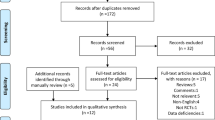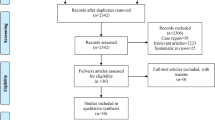Abstract
The ideal implant for the treatment of an unstable intertrochanteric femoral fracture is still a matter of discussion. The aim of this systematic review is to conduct a network meta-analysis of randomized controlled trials (RCTs) comparing clinical outcomes between dynamic hip screws (DHS), Medoff sliding plating, percutaneous compression plating (PCCP), proximal femoral nails (PFN), Gamma nails and less invasive stabilization system fixation in femoral trochanteric fractures in the elderly. These clinical outcomes consist of total intra-operative time, intra-operative fluoroscopy time, intra-operative blood loss, blood component transfusion, length of hospital stay, postoperative general complications, wound complications, late complications and reoperation rates. This systematic review was conducted using PubMed and Scopus search engines for RCTs comparing clinical outcomes between treatments from inception to February 22, 2015. Thirty-six of 785 studies identified were eligible. Compared to the other implants, PCCP showed the lowest total operative time and units of blood transfusion with an unstandardized mean difference (UMD) of 29.27 min (95% CI 5.24, 53.50) and 0.89 units (95% CI 0.52, 1.25). The lowest incidence of general complications, wound complications and late complications of PCCP was 0.09 (95% CI 0.04, 0.18), 0.01 (95% CI 0.01, 0.04) and 0.05 (95% CI 0.02, 0.11), respectively, when compared to others. The lowest fluoroscopic time was with DHS with an UMD of 0.24 min (95% CI 0.16, 0.32), whereas the lowest blood loss and shortest hospital stay were with PFN with an UMD of 233.61 ml of blood loss (95% CI 153.17, 314.04) and 7.23 days of hospital stay (95% CI 7.15, 7.31) when compared to all other fixation methods. Reoperation rates of all implants had no statistically significant difference. The network meta-analysis suggested that fixation with PCCP significantly shortens operative time and decreases the units of blood transfusion required, while also lowering risks of general complications, wound complications and late complications when compared to fixation. Use of PFN showed the least intra-operative blood loss and shortest hospital stay. Multiple active treatment comparisons indicate that PCCP fixation in trochanteric fractures in the elderly is the treatment of choice in terms of intra-operative outcomes and postoperative complications.






Similar content being viewed by others
Abbreviations
- RCTs:
-
Randomized controlled trials
- DHS:
-
Dynamic hip screws
- PCCP:
-
Percutaneous compression plating
- PFN:
-
Proximal femoral nails
- LISS:
-
Less invasive stabilization system
References
Altman DG, Bland JM (2003) Interaction revisited: the difference between two estimates. BMJ (Clin Res ed) 326(7382):219
Bojan AJ, Beimel C, Speitling A, Taglang G, Ekholm C, Jonsson A (2010) 3066 consecutive Gamma nails. 12 years experience at a single centre. BMC Musculoskelet Disorders 11:133. doi:10.1186/1471-2474-11-133
Egger M, Davey Smith G, Schneider M, Minder C (1997) Bias in meta-analysis detected by a simple, graphical test. BMJ (Clin Res ed) 315(7109):629–634
Ekstrom W, Karlsson-Thur C, Larsson S, Ragnarsson B, Alberts KA (2007) Functional outcome in treatment of unstable trochanteric and subtrochanteric fractures with the proximal femoral nail and the Medoff sliding plate. J Orthop Trauma 21(1):18–25. doi:10.1097/BOT.0b013e31802b41cf
Forte ML, Virnig BA, Eberly LE, Swiontkowski MF, Feldman R, Bhandari M, Kane RL (2010) Provider factors associated with intramedullary nail use for intertrochanteric hip fractures. J Bone Joint Surg Am 92(5):1105–1114. doi:10.2106/jbjs.i.00295
Handoll HH, Parker MJ (2008) Conservative versus operative treatment for hip fractures in adults. Cochrane Datab Syst Rev 3:CD000337. doi:10.1002/14651858.CD000337.pub2
Huang X, Leung F, Liu M, Chen L, Xu Z, Xiang Z (2014) Is helical blade superior to screw design in terms of cut-out rate for elderly trochanteric fractures? A meta-analysis of randomized controlled trials. Eur J Orthop Surg Traumatol 24(8):1461–1468. doi:10.1007/s00590-014-1429-9
Huang X, Leung F, Xiang Z, Tan PY, Yang J, Wei DQ, Yu X (2013) Proximal femoral nail versus dynamic hip screw fixation for trochanteric fractures: a meta-analysis of randomized controlled trials. Sci World J 2013:805805. doi:10.1155/2013/805805
Hutton B, Salanti G, Caldwell DM, Chaimani A, Schmid CH, Cameron C, Ioannidis JP, Straus S, Thorlund K, Jansen JP, Mulrow C, Catala-Lopez F, Gotzsche PC, Dickersin K, Boutron I, Altman DG, Moher D (2015) The PRISMA extension statement for reporting of systematic reviews incorporating network meta-analyses of health care interventions: checklist and explanations. Ann Intern Med 162(11):777–784. doi:10.7326/m14-2385
Kim WY, Han CH, Park JI, Kim JY (2001) Failure of intertrochanteric fracture fixation with a dynamic hip screw in relation to pre-operative fracture stability and osteoporosis. Int Orthop 25(6):360–362
Knobe M, Gradl G, Ladenburger A, Tarkin IS, Pape HC (2013) Unstable intertrochanteric femur fractures: is there a consensus on definition and treatment in Germany? Clin Orthop Relat Res 471(9):2831–2840. doi:10.1007/s11999-013-2834-9
Kosygan KP, Mohan R, Newman RJ (2002) The Gotfried percutaneous compression plate compared with the conventional classic hip screw for the fixation of intertrochanteric fractures of the hip. J Bone Joint Surg Br 84(1):19–22
Kristek D, Lovric I, Kristek J, Biljan M, Kristek G, Sakic K (2010) The proximal femoral nail antirotation (PFNA) in the treatment of proximal femoral fractures. Coll Antropol 34(3):937–940
Lu G, Ades AE (2004) Combination of direct and indirect evidence in mixed treatment comparisons. Stat Med 23(20):3105–3124. doi:10.1002/sim.1875
Ma KL, Wang X, Luan FJ, Xu HT, Fang Y, Min J, Luan HX, Yang F, Zheng H, He SJ (2014) Proximal femoral nails antirotation, Gamma nails, and dynamic hip screws for fixation of intertrochanteric fractures of femur: a meta-analysis. Orthop Traumatol Surg Res 100(8):859–866. doi:10.1016/j.otsr.2014.07.023
Matre K, Havelin LI, Gjertsen JE, Vinje T, Espehaug B, Fevang JM (2013) Sliding hip screw versus IM nail in reverse oblique trochanteric and subtrochanteric fractures. A study of 2716 patients in the Norwegian Hip Fracture Register. Injury 44(6):735–742. doi:10.1016/j.injury.2012.12.010
Mereddy P, Kamath S, Ramakrishnan M, Malik H, Donnachie N (2009) The AO/ASIF proximal femoral nail antirotation (PFNA): a new design for the treatment of unstable proximal femoral fractures. Injury 40(4):428–432. doi:10.1016/j.injury.2008.10.014
Palmer TMPJ, Sutton AJ, Moreno SG (2008) Contour-enhanced funnel plots in meta-analysis. STATA J 8(2):242–254
Parker MJ, Handoll HH (2010) Gamma and other cephalocondylic intramedullary nails versus extramedullary implants for extracapsular hip fractures in adults. Cochrane Datab Syst Rev 9:CD000093. doi:10.1002/14651858.CD000093.pub5
Peters JL, Sutton AJ, Jones DR, Abrams KR, Rushton L (2008) Contour-enhanced meta-analysis funnel plots help distinguish publication bias from other causes of asymmetry. J Clin Epidemiol 61(10):991–996. doi:10.1016/j.jclinepi.2007.11.010
Saarenpaa I, Heikkinen T, Ristiniemi J, Hyvonen P, Leppilahti J, Jalovaara P (2009) Functional comparison of the dynamic hip screw and the Gamma locking nail in trochanteric hip fractures: a matched-pair study of 268 patients. Int Orthop 33(1):255–260. doi:10.1007/s00264-007-0458-y
Shen L, Zhang Y, Shen Y, Cui Z (2013) Antirotation proximal femoral nail versus dynamic hip screw for intertrochanteric fractures: a meta-analysis of randomized controlled studies. Orthop Traumatol Surg Res 99(4):377–383. doi:10.1016/j.otsr.2012.12.019
Song F, Altman DG, Glenny AM, Deeks JJ (2003) Validity of indirect comparison for estimating efficacy of competing interventions: empirical evidence from published meta-analyses. BMJ (Clin Res ed) 326(7387):472. doi:10.1136/bmj.326.7387.472
Song F, Harvey I, Lilford R (2008) Adjusted indirect comparison may be less biased than direct comparison for evaluating new pharmaceutical interventions. J Clin Epidemiol 61(5):455–463. doi:10.1016/j.jclinepi.2007.06.006
StataCorp. (2014) Stata 14 base reference manual. Stata Press, College Station
Tao R, Lu Y, Xu H, Zhou ZY, Wang YH, Liu F (2013) Internal fixation of intertrochanteric hip fractures: a clinical comparison of two implant designs. Sci World J 2013:834825. doi:10.1155/2013/834825
Watson JT, Moed BR, Cramer KE, Karges DE (1998) Comparison of the compression hip screw with the Medoff sliding plate for intertrochanteric fractures. Clin Orthop Relat Res 348:79–86
Yuan X, Yao Q, Ni J, Peng L, Yu D (2014) Proximal femoral nail antirotation versus dynamic hip screw for intertrochanteric fracture in elders: a meta-analysis. Nat Med J China 94(11):836–839. doi:10.3760/cma.j.issn.0376-2491.2014.11.009
Zhang K, Zhang S, Yang J, Dong W, Wang S, Cheng Y, Al-Qwbani M, Wang Q, Yu B (2014) Proximal femoral nail vs. dynamic hip screw in treatment of intertrochanteric fractures: a meta-analysis. Med Sci Monit 20:1628–1633. doi:10.12659/msm.890962
Zhang L, Shen J, Yu S, Huang Q, Xie Z (2014) Percutaneous compression plate versus dynamic hip screw for treatment of intertrochanteric Hip fractures: a meta-analyse of five randomized controlled trials. Sci World J 2014:512512. doi:10.1155/2014/512512
Acknowledgements
All authors declare that no funding source or any sponsor involvement in the study design, collection, analysis and interpretation of the data; in writing of the manuscript; and in the submission to submit the manuscript for publication.
Authors’ contributions
AA was involved in conception and design, analysis and interpretation of the data, drafting of the article, critical revision of the article for important intellectual content, final approval of the article, collection and assembly of data. TA was involved in conception and design, drafting of the article, critical revision of the article for important intellectual content, final approval of the article, collection and assembly of data. PT was involved in conception and design, drafting of the article, critical revision of the article for important intellectual content, final approval of the article. PP was involved in conception and design, drafting of the article, critical revision of the article for important intellectual content, final approval of the article. PS was involved in conception and design, drafting of the article, critical revision of the article for important intellectual content, final approval of the article. JK was involved in conception and design, analysis and interpretation of the data, drafting of the article, critical revision of the article for important intellectual content, final approval of the article, statistical expertise, collection and assembly of data.
Author information
Authors and Affiliations
Corresponding author
Ethics declarations
Conflict of interest
All authors declare that they have no conflict of interests.
Ethical standards
This article does not contain any studies with human participants performed by any of the authors.
Appendix: Search term and search strategy
Appendix: Search term and search strategy
#1 Fracture intertrochanteric
#2 Elder
#3 Fracture femur
#4 Proximal femural nail
#5 Dynamic hip screws
#6 Gamma nail
#7 Proximal femural nail anti rotation
#8 Blood loss
#9 Hospital stay
#10 Failure rate
#11 Femeral shaft fracture
#12 Operative times
#13 Complications
#14 #1 or #2 or #3
#15 #4 or #5 or #6 or #7
#16 #8 or #9 or #10 or #11 or #12 or #13
#17 #14 and #15 and #16.
Rights and permissions
About this article
Cite this article
Arirachakaran, A., Amphansap, T., Thanindratarn, P. et al. Comparative outcome of PFNA, Gamma nails, PCCP, Medoff plate, LISS and dynamic hip screws for fixation in elderly trochanteric fractures: a systematic review and network meta-analysis of randomized controlled trials. Eur J Orthop Surg Traumatol 27, 937–952 (2017). https://doi.org/10.1007/s00590-017-1964-2
Received:
Accepted:
Published:
Issue Date:
DOI: https://doi.org/10.1007/s00590-017-1964-2




